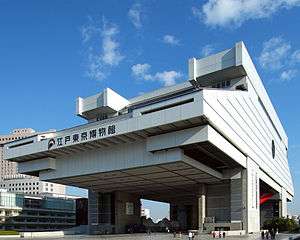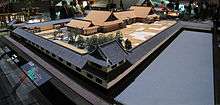Edo-Tokyo Museum
| 江戸東京博物館 | |
 | |
| Established | 1993 |
|---|---|
| Location | 1-4-1 Yokoami, Sumida, Tokyo, Japan |
| Visitors | 1,876,205 (2015)[1] |
| Website |
www |

1/30 scale architectural model of the Kamiyashiki of Matsudaira Tadamasa
The Edo-Tokyo Museum (江戸東京博物館 Edo Tōkyō Hakubutsukan) is a museum of the history of Tokyo during the Edo period.[2] It was established in 1993. The main features of the permanent exhibitions are the life-size replica of the Nihonbashi, which was the bridge leading into Edo; the Nakamuraza theatre; and scale models of towns and buildings from the Edo, Meiji and Shōwa periods. The museum is adjacent to the Ryōgoku Kokugikan. It was designed by Kiyonori Kikutake.[3] The distinctive elevated shape of the museum building is modelled after an old storehouse in the kurazukuri style.
The Edo-Tokyo Open Air Architectural Museum is a branch of the Edo-Tokyo Museum.
See also
References
- ↑ "17-12 (4): TOKYO METROPOLITAN EDO-TOKYO MUSEUM (Fiscal Years 2011~2015)". Tokyo Statistical Yearbook 2015. Retrieved 25 March 2018.
- ↑ Nussbaum, Louis-Frédéric. (2005). "Museums" in Japan Encyclopedia, pp. 671-673.
- ↑ Kiyonori Kikutake Architects Archived 2012-01-19 at the Wayback Machine., retrieved 30 July 2011
External links
| Wikimedia Commons has media related to Edo-Tokyo Museum. |
Coordinates: 35°41′47.05″N 139°47′45.97″E / 35.6964028°N 139.7961028°E
This article is issued from
Wikipedia.
The text is licensed under Creative Commons - Attribution - Sharealike.
Additional terms may apply for the media files.